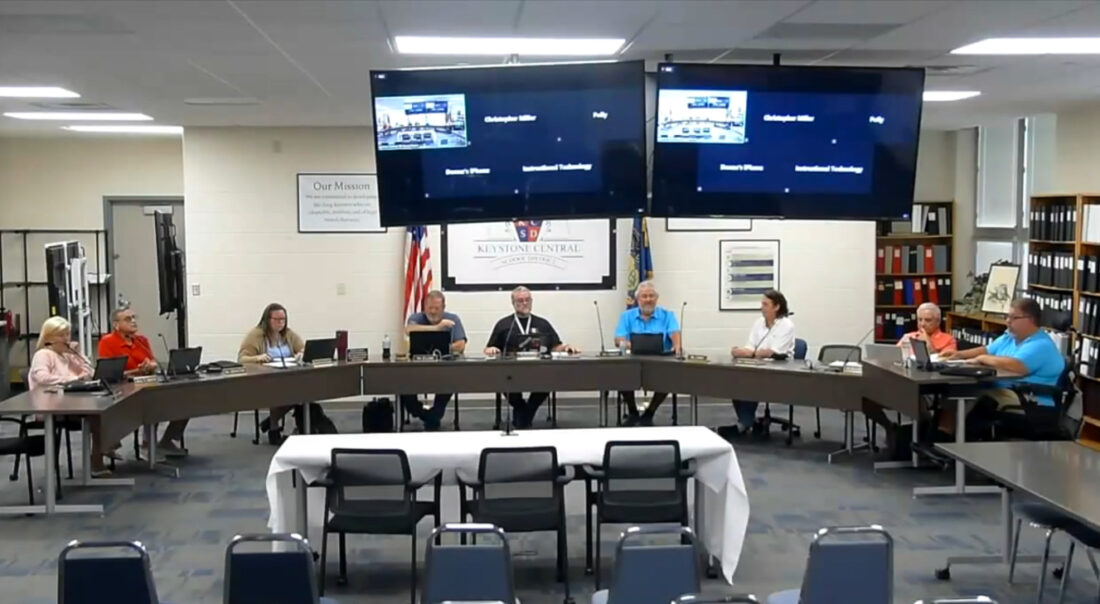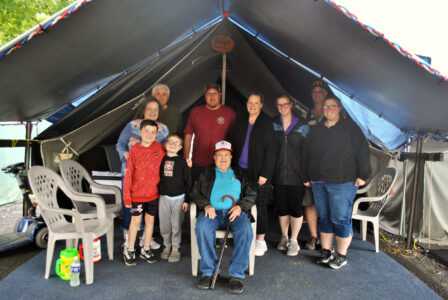Keystone Central board approves handbooks at special meeting

PHOTO PROVIDED The Keystone Central School District Board of Directors are pictured during a special meeting held Thursday night in the administration building.
MILL HALL — The Keystone Central School District Board of Directors approved student handbooks for elementary through high school during a special meeting this week.
Approval of the handbooks for the 2025-2026 year was put on hold following in-depth discussion at the board’s voting session on Aug. 14.
At the time, some members of the board expressed concerns over the replacement of the word “rules” with “expectations” in the handbooks.
At its work session earlier in the month, district staff said the change was due to aligning with Positive Behavioral Intervention and Supports (PBIS) which has been implemented across all schools.
At the voting session Assistant Superintendent Dr. Randy Zangara told the board that, though the word “rules” is replaced with “expectations” in places, there are still consequences to not meeting those expectations.
Following discussions about the handbook, the board voted down the updates with plans to review changes or updates again prior to the start of school on Aug. 26.
On Thursday night, the board held a special meeting to review the handbooks again.
Board Member Chris Scaff, who previously spoke about the language used in the handbooks, said he was happy with adjustments — particularly that the word “rules” would remain in place.
“I saw you put the word ‘rules’ back in. I’ve had discussions with a lot of people on that and (Zangara) and I went deep into it. I’m okay with it now. That was addressed,” Scaff said.
The handbooks were approved in a 7-1 vote, with Board Member Dr. Bill Baldino the lone no vote. Board Member Tom Cannon was absent from Thursday’s meeting.
Though the handbook discussion was put to bed, the board briefly discussed the use of cellphones in schools along with hoods and hats — a topic that was talked about at length during the board’s voting session last week.
The issue was brought up by board Vice President Butch Knauff, who expressed his concerns about cellphones in school.
Scaff brought up cellphone use again during the special meeting, asking if anything new might be done about it.
Scaff suggested the district implement a tiered discipline system for phones — particularly at the high school where there is permitted use outside of instructional spaces.
Zangara noted tiered discipline, which includes phones being confiscated, possible detention or parent meetings, was already included in the handbook for students who don’t follow the rules.
Superintendent Dr. Francis Redmon spoke about the different rules each building is expected to follow.
“For elementary school, cellphones are not allowed. Middle schools, during the school day they aren’t allowed. In the high schools, when they’re outside of class they’re allowed. Inside the class, no. Unless a teacher gives specific permission for them,” Redmon said.
Scaff said he was caught between members of the public that agreed with Knauff about a cellphone ban and those who were against it. He cited safety as a reason for allowing them.
Knauff said he would prefer the ban, but reiterated statements he made last week — that if the district’s cellphone policy and rules lined out in the handbook are followed — cellphones shouldn’t be an issue.
“If our policies are followed to a T there shouldn’t be an issue,” he said. “The problem is when a kid is sitting in the classroom with their hoods up… with their earbuds in listening to music when a teacher is trying to teach.”
He further noted he had no issues with hoodies being worn in schools, but the hoods should remain down.
He added kids often have smart watches, which can allow them to communicate amongst each other while their phones remain in their pockets.
“I’ve heard kids are using them for cheating in class, letting someone know what the answer to a test can be. They’re texting each other about questions,” Knauff said. “We have to be firm and make sure we’re consistent and every teacher know they’re not to have a phone out in instructional period.”
Baldino agreed with Knauff’s statements regarding both cellphones and hoods and hats being worn in schools.
“I think there’s more potential negatives for having cellphones on students during the day than any positive benefits,” he said. “The business with the hats and hoods, just don’t do it. It’s not an expectation, don’t do it.”
Scaff noted adults within the district also must set positive examples.
“We need to set an example. No using cellphones in meetings. Teachers need to set an example, not using them while teaching. Kids need to learn from examples that we’re not using them,” he said.





